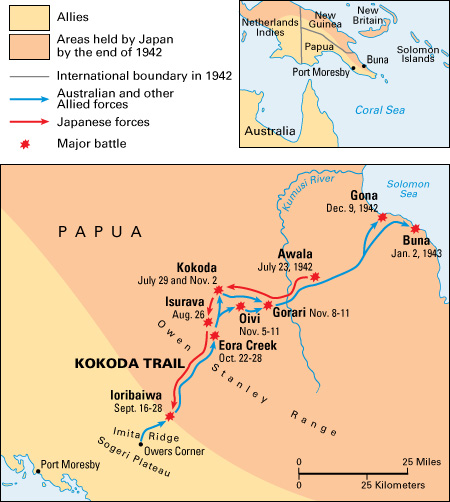Kokoda Trail, also known as the Kokoda Track, is a footpath across the Owen Stanley Ranges in Papua New Guinea, a country in the South Pacific Ocean. The trail runs from the highland town of Kokoda to the Sogeri Plateau, about 25 miles (40 kilometers) east of Port Moresby, the Papua New Guinean capital.
In the early 1940’s, Papua New Guinea was divided into two territories: New Guinea in the north, and Papua in the south. The Kokoda Trail is located entirely within the former territory of Papua. During World War II (1939-1945), Australian forces repelled a Japanese attack along the trail. United States forces aided the Australians during the campaign, as did many Papuans.
Background.
Early in World War II, Japanese forces took several key South Pacific territories. Japan then sought to capture Port Moresby, on the southern coast of Papua’s narrow eastern peninsula. Japanese control of Port Moresby would threaten Australia and support plans for further Japanese expansion in the South Pacific. In May 1942, a U.S. naval force repelled a Japanese invasion fleet in the Battle of the Coral Sea. Unable to circle Papua’s eastern peninsula, the Japanese determined to take Port Moresby by land.
The campaign.
In July 1942, a large Japanese force landed at Buna and Gona on Papua’s northeastern coast. The Japanese pushed inland to the Kumusi River, defeating a small Allied force near Kokoda. Then, in a series of small battles, the Japanese drove Australian troops back along the trail, across the Owen Stanley Range. Both sides had to contend with hot days, cold nights, torrential rains, and difficult conditions underfoot, where the trail was churned into mud. Also, neither of the armies was used to jungle warfare, especially where supply lines were strained and the countryside was steep and rugged. Tropical diseases and illness—particularly dysentery and malaria—swept through both armies.
In mid-September, the Australians halted at Imita Ridge, about 28 miles (45 kilometers) from Port Moresby. There, they were reinforced by fresh troops, including many veterans recalled from fighting in the Middle East. Facing supply problems and growing Australian resistance, the Japanese—also drained by severe losses in the nearby Battle of Guadalcanal—began retreating north along the Kokoda Trail.
In late September, the Australians began a slow advance up the trail. After a number of small, fierce battles, the Australians retook Kokoda in early November. Later that month, they forced the Japanese back across the Kumusi River. In December, Australian and U.S. troops attacked Japanese strongholds at Buna and Gona. Heavy fighting on the coast dragged into late January 1943, when the last Japanese troops were cleared from Papua.

Aftermath.
From July 1942 to January 1943, Australian battle casualties (people killed, wounded, and missing) in Papua amounted to about 6,000, including some 2,000 dead. Of these, more than 600 died on the Kokoda Trail. American casualties in Papua exceeded 3,000, with some 1,200 dead. An estimated 1,300 Papuans died during the fighting, most while serving as forced laborers for the Japanese. Japanese battle casualties exceeded 12,000, including some 10,000 killed. In addition, illness and disease caused thousands of casualties on all sides.
